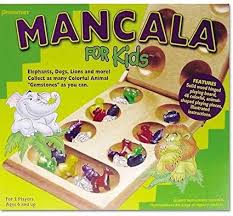Mancala: Playing an Ancient Game in the Present
Listen to the Recess! Clip
| Author | Julie Sinn |
| Air Date | 2/18/2004 |

Mancala Transcript
I’ve always looked for different games to play with my friend Angela’s daughter, Alex. When Alex was six years old, her favorite was Mancala, an ancient Egyptian counting game for two players. Unlike Hi Ho Cherri-o or Candyland, Mancala challenges players of all ages because it incorporates both counting skills and strategy. Today’s wooden gameboard consists of 48 brightly colored beads, twelve holes or “bins” lined up by twos, and a larger bin or “mancala” at each end where players collect as many beads as possible. The rules are simple enough that young Alex taught me how to play. During a turn, Alex scoops brightly colored beads out of one of the bins on her side and then drops the beads one by one in a clock-wise motion until the beads in her hand run out. With a little bit of strategy and counting skills, Alex is able to drop a bead into her large mancala bin. Then comes my turn. We scoop and drop beads, one after the other, until one of us no longer has a bead left on her side to move. The person with the most beads in her mancala wins the game.
While Alex and I have only been playing Mancala for the last eight years, the oldest Mancala boards date back over 3500 years. Archaeologists believe that the slaves who built the pyramids played mancala during rest breaks since mancala bins have been found carved into stone blocks discarded from the ancient pyramids. But Egyptian slaves were not the only people playing this strategic counting game since variations of the game can be found in Africa, India, Indonesia, and the Carribean. The ancient wealthy played on ivory boards inlayed with gold and possibly used jewels instead of beads. Those who weren’t so wealthy could easily scoop twelve small and two large bins in the ground to use as a gameboard. If need be, today’s child can easily construct a mancala board out of an egg carton.
When six-year-old Alex taught me how to play Mancala, she tended to change the counting rules mid-game so that she could win. Rather than stopping her turn when she dropped the last bead from her hand into a bin full of beads, Alex used to scoop up that bin full of beads and continue counting until her final stone landed in an empty bin. This tactic generally left her with eight or ten extra beads in her large mancala bin after only one play, and left me too far behind to even bother trying to catch up. Now that Alex is thirteen, she no longer has to find creative ways to beat me, because she has figured out how to do that by following all the rules.